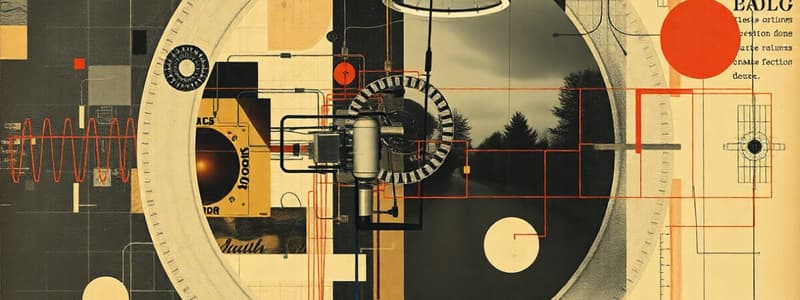Podcast
Questions and Answers
What are the elements of a measurement system?
What are the elements of a measurement system?
- a sensor, 2. a signal conditioner, 3. a display system
What is a sensor?
What is a sensor?
A sensor produces a signal related to the quantity being measured.
What components are typically included in a signal conditioner?
What components are typically included in a signal conditioner?
A signal conditioner is a device that modifies raw sensor signals into a form that can be used for data acquisition and machine control.
What are the differences between an open and closed loop system, and what are their advantages?
What are the differences between an open and closed loop system, and what are their advantages?
List the sensor performance terminology discussed.
List the sensor performance terminology discussed.
What physical properties can be measured by sensors?
What physical properties can be measured by sensors?
Describe how a potentiometer sensor works.
Describe how a potentiometer sensor works.
Explain how a strain-gauged element functions as a sensor.
Explain how a strain-gauged element functions as a sensor.
What is a capacitive element?
What is a capacitive element?
What is a differential transformer used for?
What is a differential transformer used for?
Explain how eddy current proximity sensors work.
Explain how eddy current proximity sensors work.
Describe the operating principle of an inductive proximity switch.
Describe the operating principle of an inductive proximity switch.
What is the function of optical encoders?
What is the function of optical encoders?
How do absolute encoders determine position?
How do absolute encoders determine position?
What is the typical measurement range for pneumatic sensors?
What is the typical measurement range for pneumatic sensors?
What type of action does a Microswitch require to close its contacts?
What type of action does a Microswitch require to close its contacts?
Describe a common application for a Reed switch.
Describe a common application for a Reed switch.
How do photosensitive devices detect proximity?
How do photosensitive devices detect proximity?
What is measured by Hall effect sensors?
What is measured by Hall effect sensors?
How does a tachogenerator operate?
How does a tachogenerator operate?
Explain how a strain gauge load cell measures force.
Explain how a strain gauge load cell measures force.
What quantities are piezoelectric sensors suitable for measuring?
What quantities are piezoelectric sensors suitable for measuring?
What does a tactile sensor measure?
What does a tactile sensor measure?
List mechanical and electrical methods of measuring fluid pressure.
List mechanical and electrical methods of measuring fluid pressure.
Name some devices that are used for measuring temperature.
Name some devices that are used for measuring temperature.
Why is signal conditioning necessary?
Why is signal conditioning necessary?
What is the difference between passive and active filters?
What is the difference between passive and active filters?
Why are Op-Amp circuits used?
Why are Op-Amp circuits used?
What are the ideal electrical impedance conditions for measuring and for maximizing power transfer?
What are the ideal electrical impedance conditions for measuring and for maximizing power transfer?
When would a Wheatstone bridge circuit be used?
When would a Wheatstone bridge circuit be used?
How are analog signals sampled for ADC?
How are analog signals sampled for ADC?
What is the function of actuation systems?
What is the function of actuation systems?
Describe pneumatic systems.
Describe pneumatic systems.
Describe hydraulic systems.
Describe hydraulic systems.
What is the function of valves in hydraulic and pneumatic systems?
What is the function of valves in hydraulic and pneumatic systems?
Describe linear actuators, also known as cylinders.
Describe linear actuators, also known as cylinders.
What are the purposes/uses for basic mechanisms?
What are the purposes/uses for basic mechanisms?
Flashcards
What is a sensor?
What is a sensor?
A sensor produces a signal related to the quantity being measured.
Signal conditioner?
Signal conditioner?
Signal conditioner modifies raw sensor signals for data acquisition and machine control.
Open vs. Closed Loop?
Open vs. Closed Loop?
Open loop: input independent of output (simple, low cost). Closed loop: output compared to input (accurate, adaptable).
Sensor performance terms?
Sensor performance terms?
Signup and view all the flashcards
Measurable quantities?
Measurable quantities?
Signup and view all the flashcards
Potentiometer sensor?
Potentiometer sensor?
Signup and view all the flashcards
Strain-gauged element?
Strain-gauged element?
Signup and view all the flashcards
Capacitive element
Capacitive element
Signup and view all the flashcards
Differential transformer?
Differential transformer?
Signup and view all the flashcards
Eddy current proximity sensors
Eddy current proximity sensors
Signup and view all the flashcards
Inductive proximity switch?
Inductive proximity switch?
Signup and view all the flashcards
Optical encoder?
Optical encoder?
Signup and view all the flashcards
Absolute encoder?
Absolute encoder?
Signup and view all the flashcards
Pneumatic sensors?
Pneumatic sensors?
Signup and view all the flashcards
Proximity switch: Microswitch?
Proximity switch: Microswitch?
Signup and view all the flashcards
Proximity switch: Reed switch?
Proximity switch: Reed switch?
Signup and view all the flashcards
Proximity switch: Photosensitive devices?
Proximity switch: Photosensitive devices?
Signup and view all the flashcards
Hall effect sensors?
Hall effect sensors?
Signup and view all the flashcards
Tachogenerator?
Tachogenerator?
Signup and view all the flashcards
Strain gauge load cell?
Strain gauge load cell?
Signup and view all the flashcards
Piezoelectric sensors?
Piezoelectric sensors?
Signup and view all the flashcards
Tactile sensor?
Tactile sensor?
Signup and view all the flashcards
Fluid pressure measurement?
Fluid pressure measurement?
Signup and view all the flashcards
Temperature sensors?
Temperature sensors?
Signup and view all the flashcards
Need for signal conditioning?
Need for signal conditioning?
Signup and view all the flashcards
Passive vs Active filters?
Passive vs Active filters?
Signup and view all the flashcards
Why use Op-Amp circuits?
Why use Op-Amp circuits?
Signup and view all the flashcards
Ideal impedance conditions?
Ideal impedance conditions?
Signup and view all the flashcards
When would we use Wheatstone bridge?
When would we use Wheatstone bridge?
Signup and view all the flashcards
how are analog signals are sampled for ADC?
how are analog signals are sampled for ADC?
Signup and view all the flashcards
What do Actuation systems do?
What do Actuation systems do?
Signup and view all the flashcards
Pneumatic systems?
Pneumatic systems?
Signup and view all the flashcards
Hydraulic systems?
Hydraulic systems?
Signup and view all the flashcards
Valves?
Valves?
Signup and view all the flashcards
Cylinders: Linear actuators?
Cylinders: Linear actuators?
Signup and view all the flashcards
Purpose of basic mechanisms?
Purpose of basic mechanisms?
Signup and view all the flashcards
Study Notes
- Study notes for Mechatronics Exam 1
Measurement System Elements
- A measurement system comprises a sensor, a signal conditioner, and a display system.
Sensor Definition
- A sensor generates a signal corresponding to the measured quantity.
Signal Conditioner
- A signal conditioner modifies raw sensor signals for data acquisition and machine control.
Open vs. Closed Loop Systems
- Open loop systems: Input is independent of output; advantages include simplicity and low cost.
- Closed loop systems: Output is compared to input, offering superior accuracy and adaptability through feedback.
Sensor Performance Terminology
- Range and span
- Error
- Accuracy
- Sensitivity
- Hysteresis error
- Non-linearity error
- Repeatability
- Stability
- Dead Band/time
- Resolution
- Output impedance
Measurable Quantities (Sensor Input)
- Displacement
- Position
- Proximity
- Acceleration
- Force
- Fluid pressure
- Liquid flow
- Liquid level
- Temperature
- Light
Potentiometer Sensor
- Measures linear or rotary displacement and converts it to an electrical signal.
Strain-Gauged Element
- A sensor that changes resistance with applied force, converting forces, pressure, tension, weight into a measurable electrical resistance change.
Capacitive Element
- An electrical component storing charge and responding to voltage and current changes.
Differential Transformers
- Convert linear motion (displacement) into an electrical signal.
Eddy Current Proximity Sensors
- When a metal object is near, the alternating magnetic field induces eddy currents within it.
Inductive Proximity Switch
- Consists of a coil around a core; inductance changes when near a metal object.
Optical Encoders
- Devices converting motion into a sequence of digital pulses.
Absolute Encoders
- Provide the exact position using binary numbers.
Pneumatic Sensors
- Measure displacements of fractions of mm in ranges, typically about 3 to 12 mm.
Proximity Switches: Microswitch
- A small electrical switch requiring physical contact and slight force to close.
Proximity Switches: Reed Switch
- Commonly used to monitor door closures and in tachometers for counting turns.
Proximity Switches: Photosensitive Devices
- Detect opaque objects by beam interruption or light reflection.
Hall Effect Sensors
- Measure the magnitude of a magnetic field as a voltage change.
Tachogenerator
- Operates as a generator where induced voltage is proportional to rotational speed.
Strain Gauge Load Cell
- Uses electrical resistance strain gauges to measure strain caused by force.
Piezoelectric Sensors
- Measures pressure, force, and acceleration.
Tactile Sensor
- Indicates physical contact between two objects
Measuring Fluid Pressure
- Mechanical methods: U-tube manometer, Bourdon tube, diaphragm, and bellows.
- Electrical methods: Strain gauge, capacitive sensor, potentiometric, resonant wire, piezoelectric, magnetic, optical.
Measuring Temperature
- Bimetallic strips
- Resistance temperature detectors (RTDs)
- Thermistors
- Thermodiodes and transistors
- Thermocouples
Reasons for Signal Conditioning
- Protection: Prevents damage using fuses and diodes.
- Signal Type Conversion: Converts resistance change to voltage change.
- Signal Level Adjustment: Adjusts millivolt signals to readable levels.
- Noise Reduction: Uses filters to eliminate or reduce noise.
- Signal Manipulation: Employs pulses to achieve a constant value to counter drift.
Passive vs. Active Filters
- Passive filters: Use resistors, capacitors, and inductors only.
- Active filters: Utilize operational amplifiers.
Op-Amp Circuit Use
- For signal manipulation; input signals are processed using external power to produce an output.
Ideal Electrical Impedance
- Measuring: High impedance (Rmeas >> Rsensor) to prevent power transfer.
- Maximizing power transfer: Impedance matching (Rsource = Rload).
Wheatstone Bridge Application
- Used when working with a strain gauge
Analog Signal Sampling for ADC
- ADC converts analog signals by comparing an analog signal to a digital representation of potential values, determining the smallest digital value for which the analog signal is greater.
Actuation Systems' Role
- Actuation systems convert the output of a microprocessor or control system into a controlling action on a machine or device.
Pneumatic Systems
- Systems use gas(e.g., air) to transmit force in an enclosed space.
Hydraulic Systems
- Systems using liquid (oil) to transfer force to mechanical components.
Valves
- Used in hydraulic and pneumatic systems to direct and regulate fluid flow.
Cylinders: Linear Actuators
- Cylindrical tubes with sliding pistons/rams; includes single-acting (spring return) and double-acting cylinders.
Basic Mechanisms: Purpose/Use
- Force amplification (e.g., levers)
- Speed/torque change (e.g., gears)
- Rotation transfer between axes (e.g., timing belt)
- Specific motion types (e.g., quick-return mechanism)
Studying That Suits You
Use AI to generate personalized quizzes and flashcards to suit your learning preferences.




